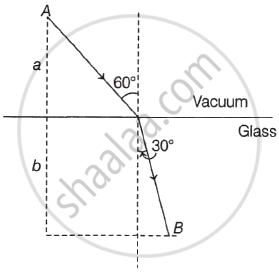Advertisements
Advertisements
Question
Obtain the equation for bandwidth in Young’s double slit experiment.
Solution
- Condition for bright fringe (or) maxima:
The condition for the constructive interference or the point P to be have a bright fringe is,
Path difference, δ = nλ
where, n = 0,1,2,…….. ∴ `"dy"/"D"` = nl
y = `"n" (lambda"D")/"d"` (or)
`"y"_"n" = "n" (lambda"D")/"d"` - Condition for dark fringe (or) minima:
The condition for the destructive interference or the point P to be have a dark fringe is,
Path difference δ = (2n -1) `λ/2`
when, n = 1, 2, 3,………..
∴ y = `(2"n" - 1)/2 (lambda"D")/"d"` (or)
`"y"_"n" = (2"n" - 1)/2 (lambda"D")/"d"` - Equation for bandwidth:
- The bandwidth (β) is defined as the distance between any two consecutive bright or dark fringes.
- The distance between (n+l)th and nth consecutive brigh fringes from O is given by,
β = `"y"_("n + 1") - "y"_"n" (("n + 1")(lambda"D")/"d") - ("n" (lambda"D")/"d")`β = `(lambda"D")/"d"`
APPEARS IN
RELATED QUESTIONS
Laser light of wavelength 630 nm is incident on a pair of slits which are separated by 1.8 mm. If the screen is kept 80 cm away from the two slits, calculate:
1) fringe separation i.e. fringe width.
2) distance of 10th bright fringe from the centre of the interference pattern
In Young’s double slit experiment, the slits are separated by 0.5 mm and screen is placed 1.0 m away from the slit. It is found that the 5th bright fringe is at a distance of 4.13 mm from the 2nd dark fringe. Find the wavelength of light used.
What are the conditions for obtaining a good interference pattern? Give reasons.
How do source and images behave as coherent sources?
Discuss the interference in thin films and obtain the equations for constructive and destructive interference for transmitted and reflected light.
Light of wavelength 600 nm that falls on a pair of slits producing interference pattern on a screen in which the bright fringes are separated by 7.2 mm. What must be the wavelength of another light which produces bright fringes separated by 8.1 mm with the same apparatus?
A thin transparent sheet is placed in front of a slit in Young's double slit experiment. The fringe width will ____________.
In Young's double slit experiment with a source of light of wavelength 5860 Å, the first maxima will occur when ____________.
If the two slits in Young's double slit experiment have width ratio 9 : 1, the ratio of maximum to minimum intensity in the interference pattern is ______.
Two identical light sources s1 and s2 emit light of same wavelength `lambda`. These light rays will exhibit interference if their ______.
In a biprism experiment, the slit separation is 1 mm. Using monochromatic light of wavelength 5000 Å, an interference pattern is obtained on the screen. Where should the screen be moved? so that the change in fringe width is 12.5 x 105 m?
In the biprism experiment, a source of monochromatic light is used for a certain distance between slit and eyepiece. When the distance between two virtual sources is changed from dA to dB, then the fringe width is changed from ZA to ZB. The ratio ZA to ZB is ______
Two waves with same amplitude and frequency superpose at a point. The ratio of resultant intensities when they arrive in phase to that when they arrive 90° out of phase is ______.
`[cos pi/2=0]`
A double slit experiment is immersed in water of refractive index 1.33. The slit separation is 1 mm, distance between slit and screen is 1.33 m. The slits are illuminated by a light of wavelength 6300 Å. The fringe width is ______.
White light is passed through a double slit and interference is observed on a screen 1.5 m away. The separation between the slits is 0.3 mm. The first violet and red fringes are formed 2.0 mm and 3.5 mm away from the central white fringes. The difference in wavelengths of red and violet light is ______ nm.
The path difference between two interference light waves meeting at a point on the screen is `(87/2)lambda`. The band obtained at that point is ______.
A ray of light AO in vacuum is incident on a glass slab at angle 60° and refracted at angle 30° along OB as shown in the figure. The optical path length of light ray from A to B is ______.

In biprism experiment, the distance of 20th bright band from the central bright band is 1.2 cm. Without changing the experimental set-up, the distance of 30th bright band from the central bright band will be ______.
